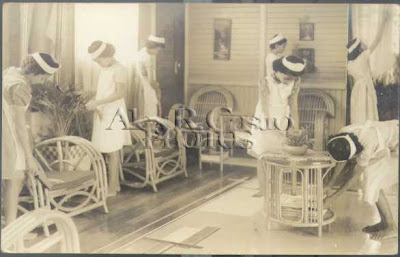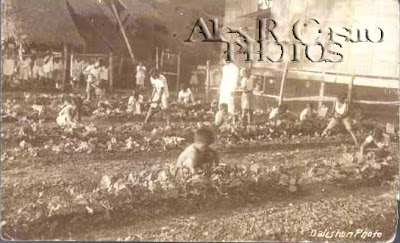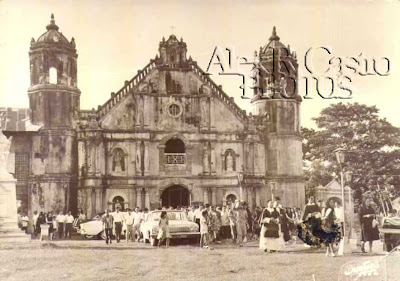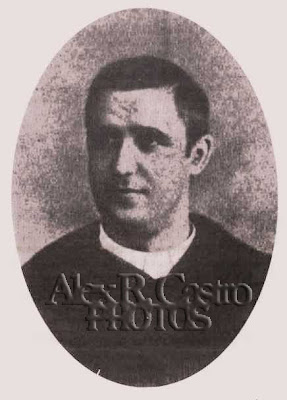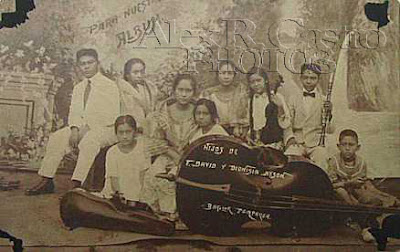 MAKING BEAUTIFUL MUSIC TOGETHER. Music runs in the family of Felicidad David and Dionisia Ayson of Bacolor as evident in this photo that shows them with their children and their musical instruments they: bajo, violin, flauta and clarinet.Ca. late 1900s.
MAKING BEAUTIFUL MUSIC TOGETHER. Music runs in the family of Felicidad David and Dionisia Ayson of Bacolor as evident in this photo that shows them with their children and their musical instruments they: bajo, violin, flauta and clarinet.Ca. late 1900s.Kapampangans have an affinity to music like no other. Just listen to the soaring vocals of international star Lea Salonga (Angeles City). Or that of comedian-singer Nanette Inventor (Macabebe), Rico J. Puno (Minalin), an exponent of OPM in the late 70s, and Mon David (Sto. Tomas). Earlier, in the ‘50s and ‘60s, the golden voices of Cenon Lagman, Tawag ng Tanghalan champion, Fred Panopio, Flor de Jesus (Joni James of the Phils.) , operatic star Fides Cuyugan-Asensio and Dario Fajardo (Harry Belafonte of the Phils.) ruled the airwaves. Kapampangans today continue to illuminate both the national and global stage with their gift of music in all its genres—pop, classical, folk—from Ysagani Ybarra of Mabalacat who uses his music for his advocacies and young singer Antoinette Taus to Leventritt Gold Medallist pianist Cecile Licad and Angeles-born Conrado del Rosario, a former student of composition of Lucio San Pedro, and winner of a Young Artist Foundation Grant who now conducts and concertizes in Europe.
Our love for music is deeply rooted in our culture. A turn-of-the century American historian observes: “Music with the Filipinos holds a high place in their esteem. And it is music such as we know that particularly appeals to them…The native has an inherent passion for music, a fact which stands as a guarantee that there is more good than evil in his composition..”.
Kapampangans have always been singing their hearts out long before the Spaniards came. Our forebears sang basultos, folk songs which contained unusual, metaphorical and paradoxical themes. Goso is a song that contains a moral message, while a pamuri, like a paninta, is a paean to love. A Kapampangan peasant also sang songs that talked of the toils of his labor or kantang pang-obra. Juvenile songs like “Sisingle, sisingle, or Bulan, Bulan, balduganan mukung palang..” were sung or chanted by children at play.
When the Spaniards came and organized colonial schools, Music, along with Latin, Rhetoric and Divinity subjects, was incorporated in the curriculum. Young women were taught in both instrumental (mostly piano, harp) and vocal branches of the art. American educators kept music as a basic subject in schools. Two years after the University of the Philippines opened its College of Music in 1916, three Kapampangans enrolled in the music course. During the schoolyear 1923-1924, Kapampangan students of music numbered 6.
The flourishing of Filipinized zarzuelas or musical plays, also deepened many a Kapampangan’s love for music. Pablo Palma of Bacolor organized his own band, Orchestra Palma, that composed the music for Juan Crisostomo Soto’s “Alang Dios”. Local bands, in fact, were staples of Pampanga town fiestas, with itinerant musicians making the rounds of balens, adding their distinct sounds to the festivities. During the re-opening of the Escuela de Artes y Oficia of Bacolor in 1893, for instance, all the towns of Pampanga were required not only to build decorative arches but also to field their brass bands to welcome the Governor General and the Archbishop of Manila.
Soon, Kapampangan bands were making their presence felt in national competitions. At the 1909 Manila Carnival band competition, the 32 member-band from Angeles won First Prize for its stirring rendition of Crème de la Crème by Tobani, under the patronage and care of Don Mariano Cunanan of Mexico. Previously, the band was under the successive batons of Prof. Higino Herrera of Angeles, Jose del Prado of Manila and Lucino Buena of Baliwag, Bulacan. The band’s instruments were all imported from Paris, France. Another band of note was the Banda ’31 founded by Temang Mangio who co-founded this famous Bacolor band with husband Pepe Baltazar of Sasmuan.
Even in the dark days of our colonial past, music kept Kapampangan heroes’ spirits up. Agapito Conchu of Guagua, executed as one of the 13 Martyrs of Cavite, played the church organ and taught music in that province. And it was said that the last request of famed revolutionary Kapitan Isabelo del Rosario before his execution was for him to play his violin one last time. His wish granted, he picked up his violin and played “Danza Havanera Filipina” while tears streamed down his eyes. When the last strain of the song faded, he smashed his violin to smithereens and calmly walked to the gallows to his death in 1901. Indeed, for the Kapampangan, music is not just in his heart, but in his blood.
(11 October 2003)








